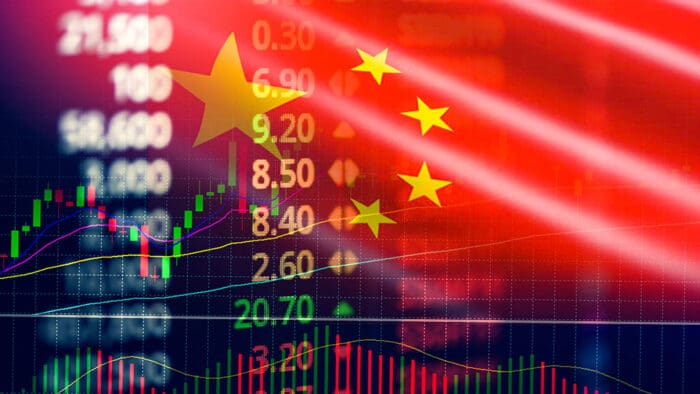Investors in Chinese ADRs received a double whammy yesterday that continues today. Despite JD.com (JD) reporting a non-GAAP profit beat and in-line revenue expectations, its customer growth failed to impress. The stock suffered the fate of many other growth stocks that reported disappointing growth, with the ADRs falling more than 15% yesterday and down another 4% this morning. In an unfortunate bit of symmetry, the 52-week high for JD was $94.40, reached exactly one year ago today, while it touched a new 52-week low of $49.03 today.
Yet that was not the only piece of negative news weighing heavily upon Chinese ADRs yesterday. The US Securities and Exchange Commission (SEC) announced that it was putting five Chinese companies on its HFCAA list. These companies were added because “the Public Company Accounting Oversight Board (“PCAOB”) has determined that it is unable to inspect or investigate completely because of a position taken by an authority in the foreign jurisdiction.” While only one of the five companies, Yum China (YUMC) is well-known to most US investors, the specter of additional regulation was not well-received.
Regulatory concerns on both sides of the Pacific have been a concern for investors in Chinese ADRs for some time. On July 6th we warned the following:
“If one invests in a Chinese company, one is exposing himself to an extra layer of uncertainty from a government that has just shown that it may not have investors’ interests in mind when making its decisions. The Chinese growth story is compelling, as are many of China’s companies, but the investment climate in that country and its companies became much more uncertain today.”
That was written in response to the Chinese regulatory response to the NYSE listing of Didi Global ADRs (DIDI). We had already seen Beijing move against Alibaba (BABA) and Ant Financial, but those might have been dismissed as displeasure with their shared leader, Jack Ma. In early July it became clear that regulatory scrutiny would no longer be focused upon a single individual and his highly successful companies. It would instead grow to encompass broader social topics like for-profit education and personal data. Later that month, we wrote:
“… some of the recent regulatory decisions [in China] seem capricious to foreign investors, and certainly are being made without regard to the prices of stocks held by investors. That type of behavior raises the perceived risk of a country, and riskier markets usually receive some sort of discount. We appear to be seeing that discount placed upon China and Hong Kong markets presently.”
As it became increasingly obvious that Beijing would be acting in its own self-interest without regard to those of investors, it also became more evident that Washington would be taking its own look at these shares. While the SEC is focus on investor protection, its goals of market transparency and fairness could have adverse effects upon the stock prices of companies that it perceives are deficient in those areas. That was what we saw yesterday, and investors clearly extrapolated those activities into other Chinese stocks. Investors crave regulatory clarity, yet I find it hard to believe that those who persistently trade in Chinese ADRs have clear visibility into the decision processes of either D.C. or Beijing.
Yet we note that BABA and NIO are consistently among the most actively traded stocks here at IBKR. It is clearly tempting to take shots at buying the dip in popular, underperforming stocks, but it has not been a rewarding activity. The following graph shows the performance of PGJ, the Invesco Golden Dragon China ETF, a common proxy for the performance of Chinese ADRs.
PGJ – One Year Daily Bar Graph

Source: Interactive Brokers
Sure, there have been tradeable bounces in PGJ and its key components, but they have tended to be fleeting. I know that I can’t successfully tell dedicated traders not to trade, and recognize that Chinese ADRs are significantly cheaper than they have been in quite some time, but it is important to recognize that Chinese ADRs remain risky and speculative until or unless we get more regulatory clarity about them on both sides of the Pacific.
Disclosure: Interactive Brokers
The analysis in this material is provided for information only and is not and should not be construed as an offer to sell or the solicitation of an offer to buy any security. To the extent that this material discusses general market activity, industry or sector trends or other broad-based economic or political conditions, it should not be construed as research or investment advice. To the extent that it includes references to specific securities, commodities, currencies, or other instruments, those references do not constitute a recommendation by IBKR to buy, sell or hold such investments. This material does not and is not intended to take into account the particular financial conditions, investment objectives or requirements of individual customers. Before acting on this material, you should consider whether it is suitable for your particular circumstances and, as necessary, seek professional advice.
The views and opinions expressed herein are those of the author and do not necessarily reflect the views of Interactive Brokers, its affiliates, or its employees.
Disclosure: Forex
There is a substantial risk of loss in foreign exchange trading. The settlement date of foreign exchange trades can vary due to time zone differences and bank holidays. When trading across foreign exchange markets, this may necessitate borrowing funds to settle foreign exchange trades. The interest rate on borrowed funds must be considered when computing the cost of trades across multiple markets.





















Join The Conversation
For specific platform feedback and suggestions, please submit it directly to our team using these instructions.
If you have an account-specific question or concern, please reach out to Client Services.
We encourage you to look through our FAQs before posting. Your question may already be covered!